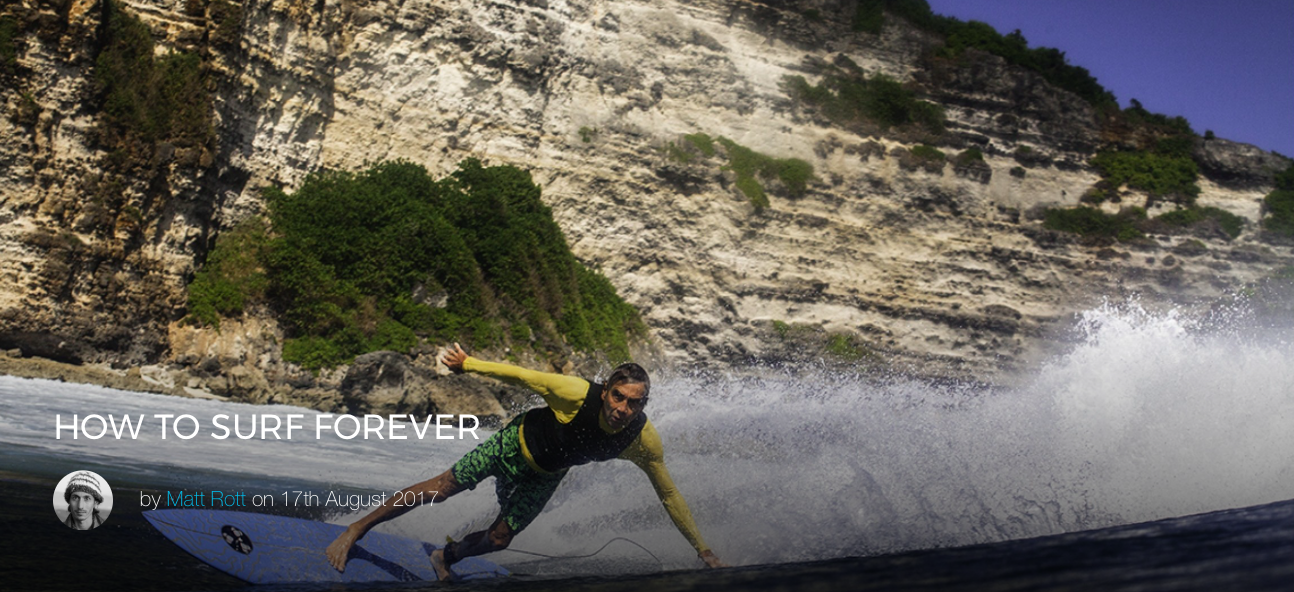HOW TO SURF FOREVER

Posted 8-17-17
A few decades ago, surfers didn’t train. With the exception of Taylor Knox (who became a fitness fanatic after a car accident almost sidelined him for life), we all just surfed, and figured that would be enough to keep us fit and in the water.
Then Mick Fanning suffered a career-ending injury, and clawed his way back to multiple world championships on the back of rigorous training. And suddenly we began to pay attention.
We began to look more closely at Mick’s regimen, and Taylor’s, and everyone else who jumped on the bandwagon. Before long, everyone on tour had a trainer and a six-pack—especially the guys who had suffered injuries and been faced with the prospect of not being able to surf anymore.
But what if we didn’t need to get injured to get motivated to stay healthy. What if we just stayed healthy, and in that way avoided getting injured? That’s what chiropractor/surfer/holistic health advocate Tim Brown is all about. Tim hands out rubdowns and advice to the best surfers in the world, so we thought we’d pick his brain about what the average wave rider can do to stay healthy and surf into their 80s. Here’s what he had to say.
On Maintaining and Improving Mobility
Have you ever watched an older surfer paddle? Their head is pinned to the board because the forward posture you assume at work becomes your default posture, and you end up having to contend the tight chest, underarm, and shoulder muscles that have adapted to life outside of the water. And that’s just the upper body! While you are sitting, your hips become short and tight, making it painful to paddle and hard to pop up like you did when you were young.
Maintaining mobility is essential to continue ripping into your 60s and beyond. Remember when it comes to muscles that you must make them longer to be stronger. Length before strength is the name of the game.
Always Warm Up
Switching on your surfing muscles and connecting the mind and body through the breath is a great way to prep your body for a great surf—and it allows you to move better while in the water. Performing movements that mimic surfing is the way to go, so try to focus on opening the chest, warming up the shoulders, and probably most importantly, activating your hips.
They are your largest muscle, and therefore pump the most blood through your body. Warming up the hips lets you feel like you can go harder faster, because you surf lower and can access the core muscles that allow for smoother and more powerful transitions with less effort.
Don’t Forget to Cool Down
Surfers tend to collapse into poor posture after a long session because the muscles you use to paddle and the muscles around your hips tend towards shortening after a surf. It’s crucial to open the muscles you use for the quickest possible recovery, to prevent injury and reap the full physical and mental benefits of the exercise that surfing provides. Be a floor dweller. Do not sit on chairs, and after you drive home from a surf, make sure you recover in positions and postures that make you long and open, as opposed to be in positions that round your shoulders and spine. Do not sit on chairs, and after you drive home from a surf, make sure you recover in positions and postures that make you long and open
Learn to stretch your hips by doing slow, dynamic movements that involve the muscles that move them. You can also learn static yoga stretches, and even combine the two approaches.
The key is maintaining blood flow because it flushes and feeds the muscles that have shortened and filled with lactic acid waste products during activity. This speeds recovery and helps maintain quality and range of movement, which is essential for improving your water game.
Also, try to hydrate after a surf session, until your urine is clear or pale lemonade color (if it’s darker orange, you are dehydrated and need to start drinking until you need to pee). Eat a healthy snack with protein and a bit of carbohydrates to refuel your muscles. It is also helpful to learn breathing techniques, such as Hatha yoga, Wim Hoff breathing, balloon, ginastica natural, etc. There are lots to choose from, and they all have a great effect on mood, performance, and recovery. We are also beginning to discover breathing’s protective ability to brace the body during movement.
Let Wim talk you through some of his techniques.
To me, breath is the great connector of mind and body. Try sitting up and taking a slow, deep breath through your nose, and then slowly letting it out for 8-12 seconds—the slower the better. You can let it out slowly by placing the tip of your tongue against the roof of your mouth. This restricts the release and puts pressure on the back of the throat, where a key nerve is that responds by calming your nervous system. This gets rid of stress, and puts you into a super calm (parasympathetic) state—“the zone.”
Ultimately, the goal is to proactively keep your body long, strong, limber and connected. By doing these things preemptively, you can avoid the inflexibility and stagnation that leads to injury and disease, and ultimately keeps you out of the water.
Cover image: Gerry Lopez, the epitome of health on his recent return to Bali.

(c) Towsurfer.com 2017







